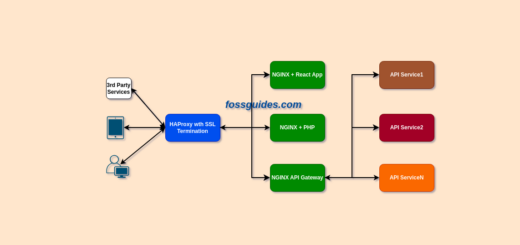Best Open-Source Load Balancers for Linux Servers
There are several open-source software load balancers available for Linux systems. Here are some popular options that you might use in production:
1. HAProxy
HAProxy (short for High Availability Proxy) is a free, open-source, widely-used software that offers load balancing and high availability for TCP and HTTP-based applications. It can handle high-traffic volumes and distribute requests across multiple servers to improve performance, availability, and scalability.
HAProxy is commonly used in web applications, where it acts as an intermediary between clients and servers. It can route requests based on a variety of criteria, such as the client’s IP address, the requested URL, or the server’s health status. HAProxy supports various load-balancing algorithms, including round-robin, least connections, and IP hash.
In addition to load balancing, HAProxy also provides features such as SSL/TLS termination, content switching, request queuing, and traffic shaping. It can be configured through a command-line interface or a web-based user interface, and it supports various logging and monitoring tools to help administrators troubleshoot issues.
HAProxy is widely used in production environments and is known for its high performance, reliability, and flexibility. It is compatible with many operating systems and platforms, including Linux, FreeBSD, Solaris, and Microsoft Windows.
HAProxy website: https://www.haproxy.org/
2. NGINX
NGINX (pronounced “engine-x”) is a popular, free, open-source web server and reverse proxy software that also works perfectly as a load balancer. It is known for its high performance, scalability, and reliability, and is often used to handle large amounts of web traffic. NGINX can be used as a standalone server or in combination with other web servers and is often used as a load balancer and caching server in modern web architectures.
NGINX was first released in 2004 by Igor Sysoev, a Russian software engineer, and has since gained widespread popularity among developers and system administrators. In addition to its core functionality as a web server and reverse proxy, NGINX also includes features such as URL rewriting, SSL/TLS termination, and support for various programming languages and frameworks.
NGINX is released under the terms of the BSD-like 2-clause license. Commercial support and additional features are also available from NGINX, Inc., the company that provides official support and development for the software.
NGINX website: https://nginx.org/
3. Træfɪk
Traefik is an open-source reverse proxy and load balancer that is designed to handle multiple backends with minimal configuration. It was developed by Emile Vauge and released in 2015. Traefik can be used to route HTTP, HTTPS, and TCP traffic to various services, including Docker containers, Kubernetes pods, and standalone applications.
Traefik supports dynamic configuration, which means that it can automatically discover new backends as they are added and remove them when they are no longer available. It also supports various load-balancing algorithms, including round-robin, random, and least connections. Additionally, Traefik provides advanced features such as circuit breakers, retries, and timeouts.
Traefik has gained popularity due to its ease of use, flexibility, and support for modern infrastructure technologies such as Docker and Kubernetes. It also provides a web dashboard and an API for monitoring and managing traffic. Traefik is licensed under the MIT License and is available for free on GitHub.
Træfɪk Github repository: https://github.com/traefik/traefik
4. Seesaw
Seesaw load balancer is a software-based load balancer that is designed to distribute network traffic across multiple servers or virtual machines. It is an open-source load balancer that was developed by Google, and it is designed to provide high availability, scalability, and performance.
The seesaw load balancer works by monitoring the health and availability of the servers in the pool and distributing traffic to the servers that are currently online and responding to requests. It uses a variety of algorithms to determine how to distribute traffic, including round-robin, least connections, and IP hash.
One of the benefits of using a seesaw load balancer is that it is highly configurable and can be customized to meet the specific needs of a particular application or environment. It also supports a wide range of protocols, including TCP, HTTP, and HTTPS.
Another advantage of Seesaw is its ability to perform SSL termination, which offloads the SSL processing from the backend servers, allowing them to focus on other tasks. Seesaw can also perform content switching, which enables it to route traffic to different servers based on the content of the request.
Overall, the seesaw load balancer is a powerful and flexible tool for managing network traffic and ensuring the availability and reliability of applications and services.
Seesaw Github repository: https://github.com/google/seesaw
Conclusion
All of these options have their own unique features and benefits, and the choice depends on your specific needs and requirements. Remember that in the comments box, you can express what you think about this article.



